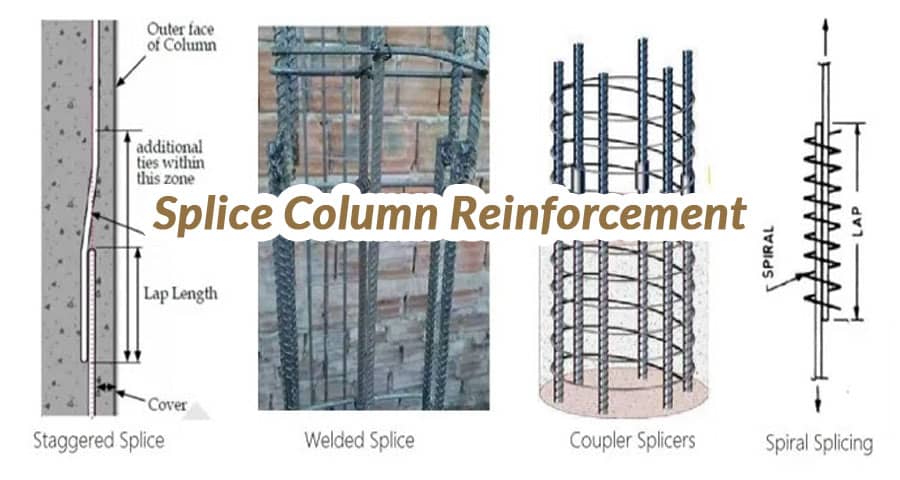How to Splice Column Reinforcement as per Indian Standard

Splicing column reinforcement is a critical aspect of reinforced concrete construction. It ensures continuity, structural integrity, and adherence to safety standards, particularly in compliance with Indian Standards (IS codes).
Understanding Column Reinforcement Splicing
Column reinforcement splicing involves overlapping or connecting two reinforcing bars to transfer loads effectively while maintaining the structural integrity of the column. It is particularly necessary when the length of the reinforcement bar is insufficient to cover the entire span of the column. Indian Standard IS 456:2000 and related codes provide the technical requirements for splicing.
Types of Splicing in Column Reinforcement
1. Lap Splicing
Lap splicing is the most common technique where two bars are overlapped over a specified length to ensure load transfer. This method is cost-effective and easy to execute.
Key considerations for lap splicing:
- Minimum lap length should be 60 times the diameter of the bar (Ld) for tension members, as per IS 456:2000.
- The lap should be staggered to prevent congestion and ensure smooth concrete flow.
- Bars of differing diameters should not be lapped directly without proper design checks.
2. Welded Splicing
Welding involves joining bars through electrical or gas welding. It is commonly used for high-strength applications where lap splicing is impractical.
Important guidelines for welded splicing:
- Use only qualified welders for reinforcement welding.
- Test welds to ensure compliance with IS 2751:1979.
- Avoid welding on site unless absolutely necessary.
3. Mechanical Couplers
Mechanical splices involve using couplers to connect the bars. This method ensures high efficiency and eliminates congestion in heavily reinforced columns.
Advantages of mechanical splicing:
- Superior performance under high loads.
- Faster installation compared to other splicing methods.
- Suitable for large-diameter bars.
Guidelines for Splicing as per Indian Standards
1. Location of Splices
- Splices in columns should be placed away from areas of maximum stress.
- Typically, splices are located near the middle third of the column height.
- Avoid splicing all bars in the same cross-section; staggered splicing is recommended.
2. Bar Arrangement and Staggering
- Bars should be placed evenly around the column circumference.
- Staggered splicing ensures uniform load transfer and prevents stress concentration.
- Maintain clear spacing between bars to facilitate proper concrete compaction.
3. Splice Length Requirements
- Tension Members: Minimum lap length = Ld = 60 times the bar diameter.
- Compression Members: Minimum lap length = 48 times the bar diameter.
- Splice length should increase in poor concrete conditions or when smaller bars are connected to larger ones.
4. Bar Diameter Restrictions
- Do not splice bars larger than 36 mm in diameter using lap splicing. Use mechanical couplers or welding for larger bars.
5. Concrete Cover and Bond Strength
- Ensure proper cover to prevent exposure to environmental conditions.
- Use high-strength concrete for improved bond strength, particularly in splicing zones.
Steps for Effective Splicing in Columns
1. Planning and Layout
- Conduct structural analysis to determine the optimal splicing locations.
- Avoid placing splices near beam-column junctions or high-stress zones.
2. Execution of Splicing
- Cut bars to the required length with precision.
- Ensure clean and rust-free surfaces for bars to enhance bonding.
- Position bars correctly according to the layout plan, maintaining clear spacing.
3. Quality Checks
- Inspect the reinforcement cage for compliance with design specifications.
- Verify lap lengths, coupler installations, or weld quality.
- Conduct pull-out tests to assess splice strength, especially for critical structures.
Common Mistakes to Avoid
- Improper Staggering: Splicing all bars in the same cross-section reduces column strength.
- Insufficient Lap Length: Using shorter lap lengths compromises load transfer efficiency.
- Neglecting Concrete Cover: Inadequate cover can lead to corrosion and reduced durability.
- Overcrowding of Bars: Poor bar placement hinders concrete flow, leading to weak zones.
Advantages of Proper Column Splicing
- Enhanced load transfer capacity and structural integrity.
- Compliance with safety standards and reduced failure risks.
- Improved durability and resistance to environmental factors.
- Economical and efficient use of reinforcement materials.
Conclusion
Splicing column reinforcement as per Indian Standards is an essential practice that directly impacts the strength and safety of a structure. By adhering to the guidelines in IS 456:2000, ensuring proper splicing techniques, and avoiding common errors, construction professionals can achieve high-quality, durable results. Always prioritize thorough planning, precise execution, and rigorous quality checks to ensure the success of your reinforcement splicing process.
For more information, please watch the video tutorial
